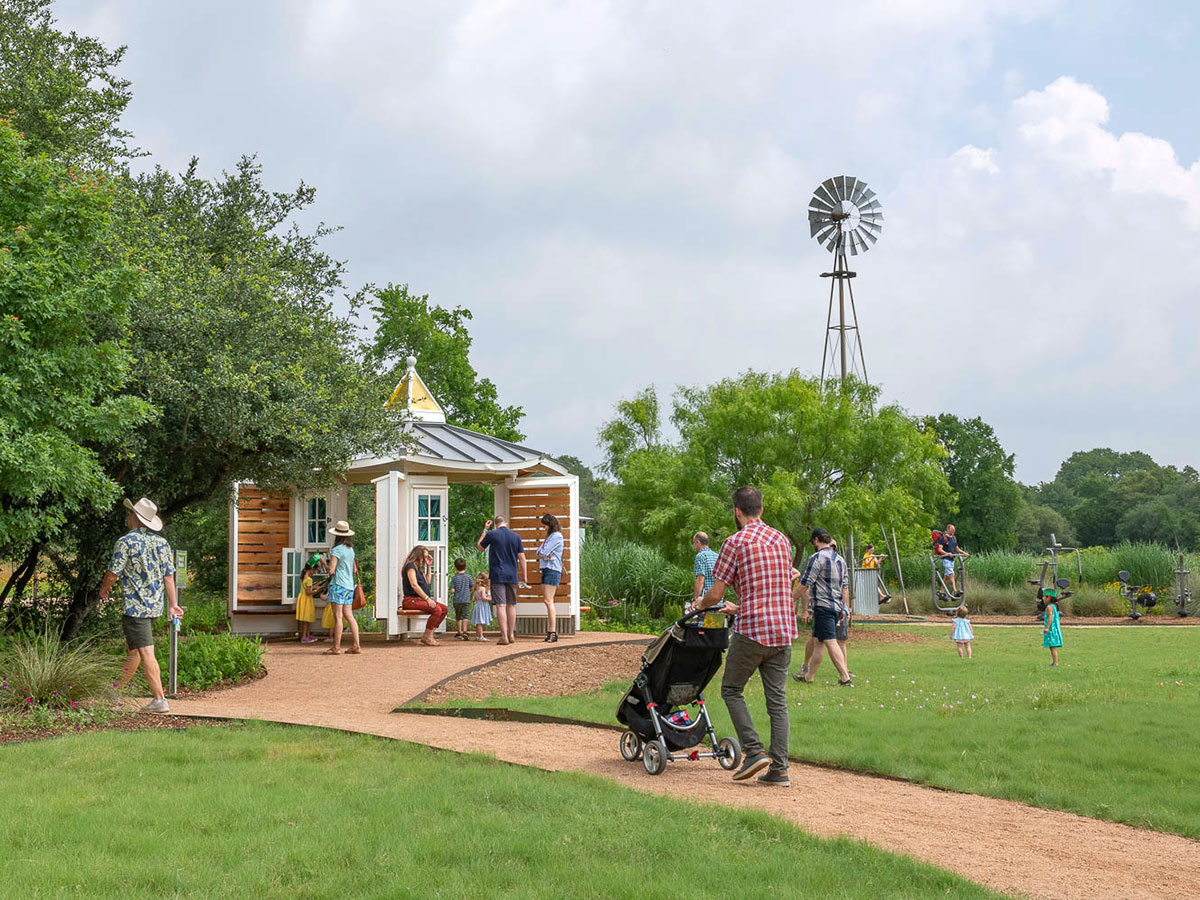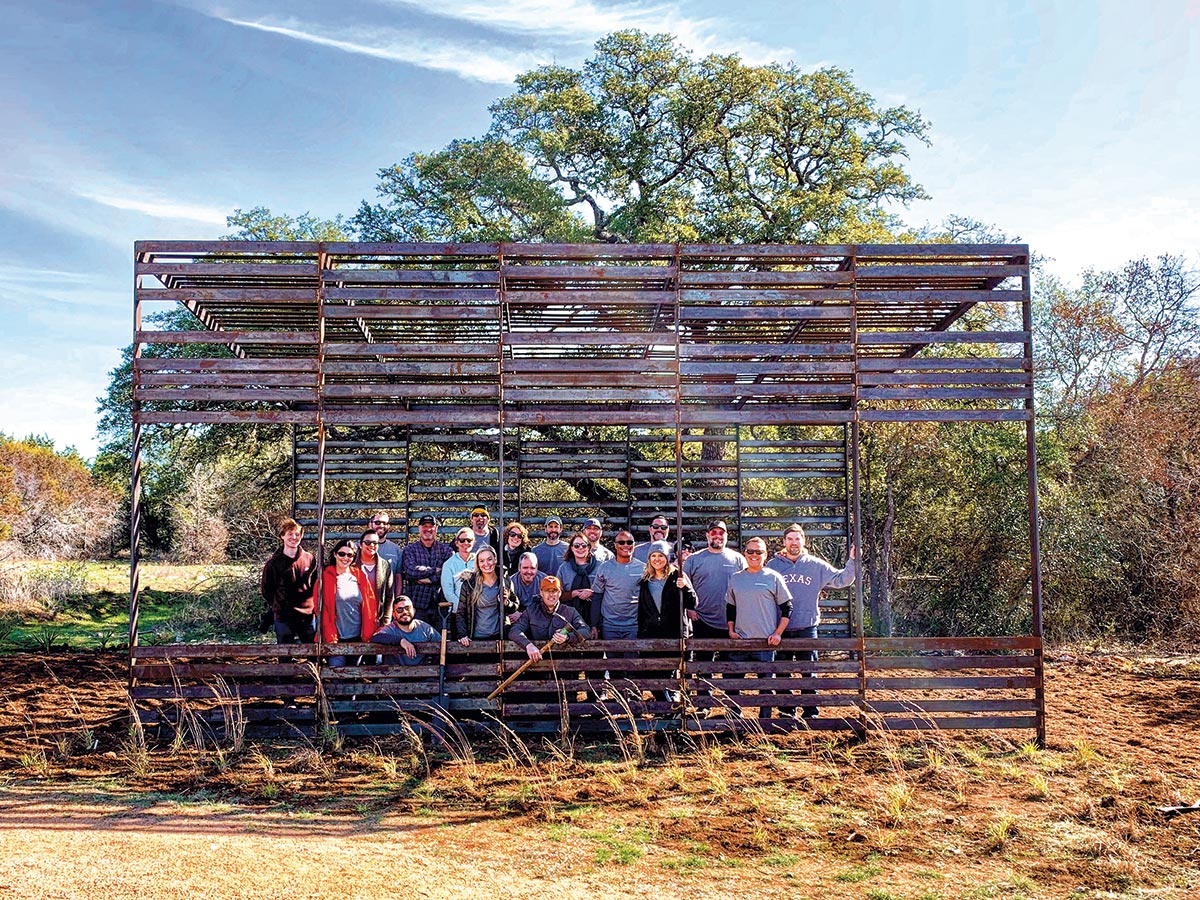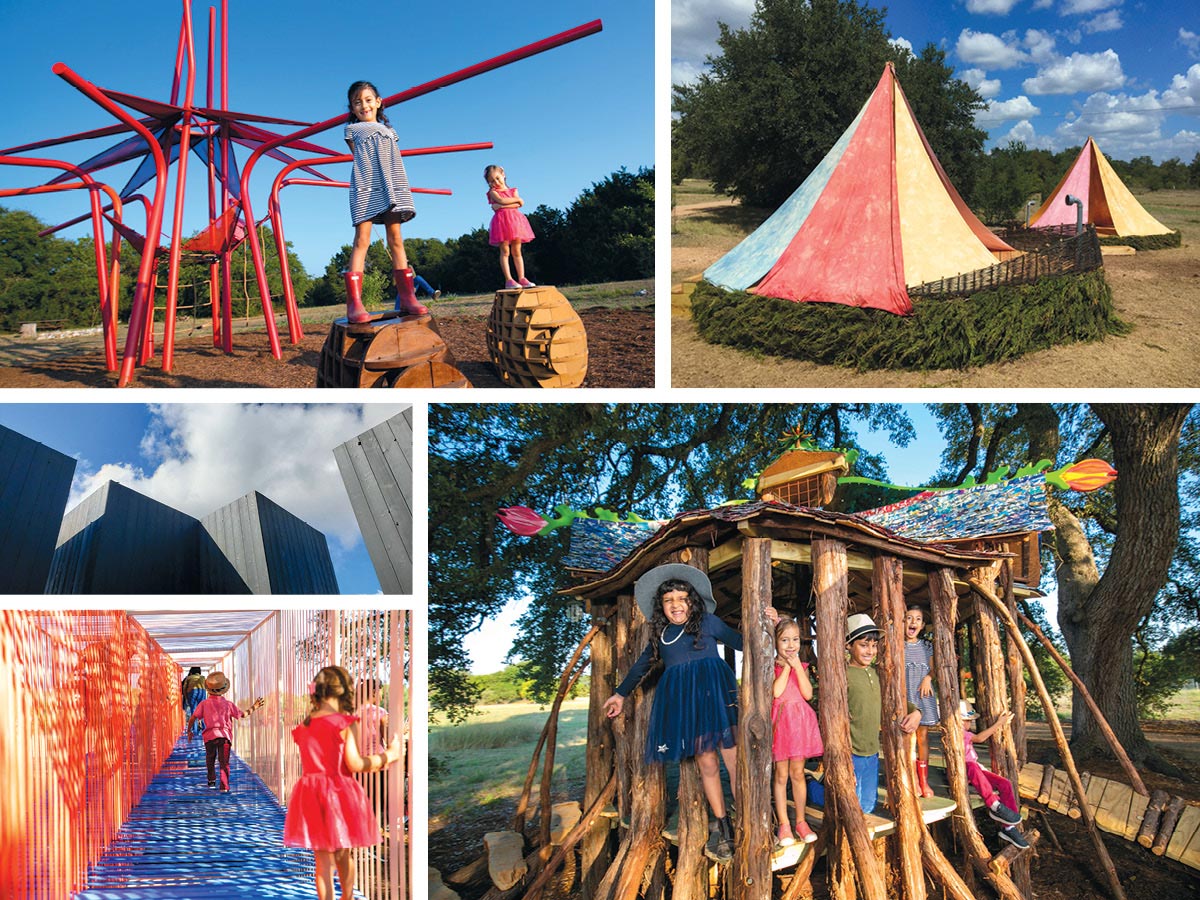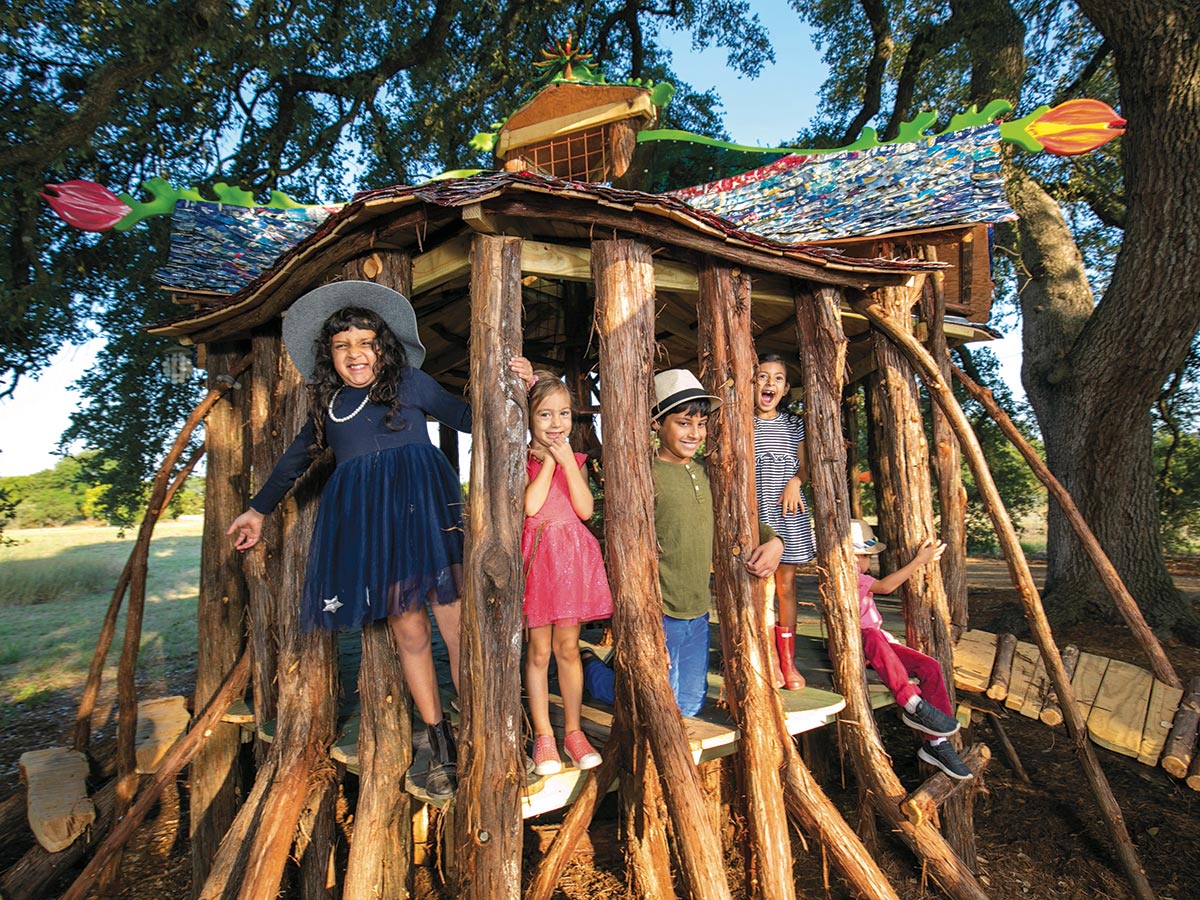Centered: Spring/Summer 2020

Guests enjoying Lynda’s Library in the Family Garden. PHOTO Bruce Leander
Growing Minds
Does your child need a break in the shade after a day of nature play? Lynda’s Library, a place for kids to read, opened in the Luci and Ian Family Garden in April 2019. “It’s nice seeing parents with their young children relaxing and reading together,” says Family Garden horticulturist Karen Beaty. Guests can also donate their own lightly used children’s books to the library to pass on the joy of reading to another child. The library was given in honor of Lynda Johnson Robb by her sister, Luci Baines Johnson. One of Lynda’s passions in life is promoting children’s literacy.
On Site and Hands On
Sculptor Merideth Hillbrand was awarded the St. Elmo Arts Residency and Fellowship for the 2019-20 academic year. The residency is a joint program between the Department of Art and Art History and the Wildflower Center at The University of Texas at Austin. She will teach courses at UT and the Wildflower Center, as well as hold a public exhibition at the Center in April 2020.
Hillbrand, who recently received an MFA from the University of California, Riverside, says this of the Wildflower Center’s influence on her work: “I’ve been thinking a lot more about plant structures and how things grow as a contrast to my focus on architecture, which is much more planned and designed. In gardens, there’s a diversity to looking, so many different things to observe.”
On Austin Museum Day 2019, she taught a children’s sculpture workshop, noting, “It’s really inspirational to work with younger students and see what they engage with.” Hillbrand will lead an upcoming course at the Center where adult students can create petite ceramic planters for their home gardens. “I really like to work hands-on with people,” she says.

One of the new structures along the Simmons Research Trail. PHOTO John Hart Asher
Trail Blazing
The Wildflower Center’s Restoration Research Trail, which transects a 70-acre area of native grasses, trees and wildflowers, has been renamed the Simmons Research Trail in honor of Dr. Mark Simmons, who passed away in 2015. Simmons was the director of ecological research and design and significantly impacted projects and practices at the Center, such as implementing the use of prescribed fires since 2001.
His work focused on restoring natural landscapes and building urban green spaces to increase environmental benefits for humans and wildlife. “Mark really believed that people have the power to heal the environment,” says Lee Clippard, the Center’s director of communications.
The Simmons Research Trail, with major support from the Lebermann Foundation, will include updated signage describing how we can positively impact land through wise management practices, as well as several new field stations designed pro bono by notable architecture firm Lake|Flato. The Fire Station will feature an elevated walkway where guests can observe ongoing research about human intervention within the oak savanna ecosystem. There will also be a Wildlife Station, allowing guests to further connect with the abundant animal life, such as bobcats, coyotes and a variety of birds, that can be observed at the Center. The new Roadrunner Trail, made possible through a generous donation from Jeanie and Thomas Carter, connects this refurbished area to the Texas Arboretum, giving guests more convenient access to both.
Through the renaming and improvement of the Simmons Research Trail, Mark’s legacy of innovative research and deep care for the native environment of Texas will be remembered.

A selection of forts from Fortlandia 2019 (clockwise from top left): B-A-B, Fortmosa, Fairy Pavilion, Color Trail and SKYFORT, PHOTOS Brian Birzer, Lee Clippard, B. Birzer x 2, dwg.
Fortlandia 2.0
Whether playing or imagining in the Fairy Pavilion or climbing to new heights on B-A-B, guests thoroughly enjoyed their time at the second edition of Fortlandia. “I’ve heard a lot of comments about how much guests loved the first year,” says Tanya Zastrow, the Center’s director of programs, “but they loved 2019 even more.” The numbers don’t lie: 62,000 people visited from October through December 2019, a 70% increase over the same period in 2018.
Fortlandia gave guests the opportunity to experience the natural world with a fresh perspective. With many forts referencing particular parts of the local environment, guests learned about nature while engaging with the structures. “It got people out and moving with nature,” says Zastrow. “It was a great benefit, physically and mentally.”
Forts such as Hamaca de Flores took inspiration from the iconic imagery of rolling hills of bluebonnets, while others were influenced by the Center’s namesake. “In our research of Lady Bird Johnson, we read that [Indian paintbrush and bluebonnets] were her favorite flowers,” says Sean Guess, a designer with Faye and Walker, makers of Color Trail. “That was the reason we chose those colors for our fort.”
Fortlandia also created opportunities for adults to get in touch with their inner child and use their imaginations through nature play. “We were here for opening weekend, and we heard these guests talking about how they felt like kids again after playing in our fort,” says Hidden in Plain Sight designer Daniela Valle of Nelsen Partners. “I think that’s something really treasured — to capture that inner kid we all have and experience it all over again.”
The forts gave families the chance to play and explore together, creating memories that will last for years to come. “As our executive director says, we are in the business of creating emotional souvenirs,” says Zastrow. “There were memories being created out there minute by minute.”

Guests enjoying Lynda’s Library in the Family Garden. PHOTO Bruce Leander
Growing Minds
Does your child need a break in the shade after a day of nature play? Lynda’s Library, a place for kids to read, opened in the Luci and Ian Family Garden in April 2019. “It’s nice seeing parents with their young children relaxing and reading together,” says Family Garden horticulturist Karen Beaty. Guests can also donate their own lightly used children’s books to the library to pass on the joy of reading to another child. The library was given in honor of Lynda Johnson Robb by her sister, Luci Baines Johnson. One of Lynda’s passions in life is promoting children’s literacy.
On Site and Hands On
Sculptor Merideth Hillbrand was awarded the St. Elmo Arts Residency and Fellowship for the 2019-20 academic year. The residency is a joint program between the Department of Art and Art History and the Wildflower Center at The University of Texas at Austin. She will teach courses at UT and the Wildflower Center, as well as hold a public exhibition at the Center in April 2020.
Hillbrand, who recently received an MFA from the University of California, Riverside, says this of the Wildflower Center’s influence on her work: “I’ve been thinking a lot more about plant structures and how things grow as a contrast to my focus on architecture, which is much more planned and designed. In gardens, there’s a diversity to looking, so many different things to observe.”
On Austin Museum Day 2019, she taught a children’s sculpture workshop, noting, “It’s really inspirational to work with younger students and see what they engage with.” Hillbrand will lead an upcoming course at the Center where adult students can create petite ceramic planters for their home gardens. “I really like to work hands-on with people,” she says.

One of the new structures along the Simmons Research Trail. PHOTO John Hart Asher
Trail Blazing
The Wildflower Center’s Restoration Research Trail, which transects a 70-acre area of native grasses, trees and wildflowers, has been renamed the Simmons Research Trail in honor of Dr. Mark Simmons, who passed away in 2015. Simmons was the director of ecological research and design and significantly impacted projects and practices at the Center, such as implementing the use of prescribed fires since 2001.
His work focused on restoring natural landscapes and building urban green spaces to increase environmental benefits for humans and wildlife. “Mark really believed that people have the power to heal the environment,” says Lee Clippard, the Center’s director of communications.
The Simmons Research Trail, with major support from the Lebermann Foundation, will include updated signage describing how we can positively impact land through wise management practices, as well as several new field stations designed pro bono by notable architecture firm Lake|Flato. The Fire Station will feature an elevated walkway where guests can observe ongoing research about human intervention within the oak savanna ecosystem. There will also be a Wildlife Station, allowing guests to further connect with the abundant animal life, such as bobcats, coyotes and a variety of birds, that can be observed at the Center. The new Roadrunner Trail, made possible through a generous donation from Jeanie and Thomas Carter, connects this refurbished area to the Texas Arboretum, giving guests more convenient access to both.
Through the renaming and improvement of the Simmons Research Trail, Mark’s legacy of innovative research and deep care for the native environment of Texas will be remembered.

Fairy Pavilion, designed by James Edward Talbot and winner of Fortlandia’s first People’s Choice Award. PHOTO Brian Birzer
Fortlandia 2.0
Whether playing or imagining in the Fairy Pavilion or climbing to new heights on B-A-B, guests thoroughly enjoyed their time at the second edition of Fortlandia. “I’ve heard a lot of comments about how much guests loved the first year,” says Tanya Zastrow, the Center’s director of programs, “but they loved 2019 even more.” The numbers don’t lie: 62,000 people visited from October through December 2019, a 70% increase over the same period in 2018.
Fortlandia gave guests the opportunity to experience the natural world with a fresh perspective. With many forts referencing particular parts of the local environment, guests learned about nature while engaging with the structures. “It got people out and moving with nature,” says Zastrow. “It was a great benefit, physically and mentally.”
Forts such as Hamaca de Flores took inspiration from the iconic imagery of rolling hills of bluebonnets, while others were influenced by the Center’s namesake. “In our research of Lady Bird Johnson, we read that [Indian paintbrush and bluebonnets] were her favorite flowers,” says Sean Guess, a designer with Faye and Walker, makers of Color Trail. “That was the reason we chose those colors for our fort.”
Fortlandia also created opportunities for adults to get in touch with their inner child and use their imaginations through nature play. “We were here for opening weekend, and we heard these guests talking about how they felt like kids again after playing in our fort,” says Hidden in Plain Sight designer Daniela Valle of Nelsen Partners. “I think that’s something really treasured — to capture that inner kid we all have and experience it all over again.”
The forts gave families the chance to play and explore together, creating memories that will last for years to come. “As our executive director says, we are in the business of creating emotional souvenirs,” says Zastrow. “There were memories being created out there minute by minute.”

